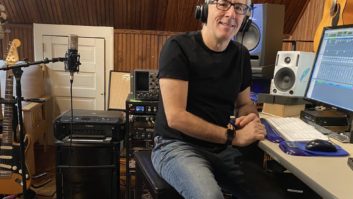Everybody has a Web site-companies, organizations, freelance engineers and, yes, recording studios. But it seems the conventional Web site is evolving in the studio world, from a resource for basic information into a possible source of revenue.
Granted, Web sites haven’t exactly proven to be money-makers, but they have been money-savers, at least in the area of postage and human resources. “It’s practical but not really financially rewarding,” observes Zoe Thrall, studio manager at Avatar Recording in New York City, adding that one or two sessions have come in through the site during the past year. “But it’s been very good in that we don’t have to print and send out a lot of elaborate brochures-which can cost a significant amount of money-and spend the time packaging them, mailing them out and following up. At the site, engineers and producers can get a good idea of the studios, what the equipment is, what the microphone closet has to offer. It’s also an e-mail center for us, and we’ve gotten some resumes in off it.”
Basic Web sites can track the number of hits on a page, but most studios haven’t seemed all that interested in being interactive beyond e-mail. “We’ve had our Webmaster track our hits, but no real pattern has emerged in the three years we’ve had it up, so it’s not something I bother much about,” says Dave Amlen, owner of Sound On Sound Studios in Manhattan. He has, however, hooked up with other sites, providing reciprocal links between his site and Solid State Logic, Bryston and Neve.
Other possibilities are being explored across the country. At Nashville’s Starstruck Studios’ site, three-dimensional renderings are accessible by mouse movements, allowing viewers to virtually walk the floors and peer into the rafters of the facility. Starstruck, which developed the site in-house and promoted it to the trade media as assertively as many facilities do for major new console acquisitions, originally expected that the site would serve as an elaborate marketing tool. However, Robert de la Garza, vice president of Starstruck’s studio and broadcast operations, says that the site has succeeded as a sales tool, as well.
“It was always intended to help us market the studio outside of Nashville,” he explains. “But the real benefit has been that it has helped sell the studio to new overseas clients, clients who already knew that they wanted to come to the U.S. to work-and possibly even knew they wanted to come to Nashville-but who needed to choose a studio and had to do that before they left their home country.” Starstruck has closed eight foreign deals thus far, says de la Garza, including projects from Brazil and Australia.
But what about the Web site as a business? In Nashville, Sound Stage Studios had been taking the conventional route with its site, listing room dimensions, equipment, microphones, discography and other related information. But earlier this year the facility created a far more complex and far more interactive site, listing not only the basics but also acting as a center for information exchange, including message boards, technical questions and classified advertising. According to studio general manager Michael Koreiba, “Other types of advertising are being planned for the future-not just for the studio, not just within pro audio. Any kind of advertising is under consideration. Whatever would work within the context.” Initially it will likely stay within pro audio, Koreiba says, and include advertising from audio educational facilities and equipment manufacturers.
Sound Stage’s long-term plans for its site include gathering as much information as possible from those who enter it, a process known as qualifying data. “We’ll send out memberships to the Web site and send people a little gift in exchange for information,” says Koreiba. That data could, in turn, enhance the price it can sell advertising space for on its site.
Retail and e-commerce provide perhaps the most obvious moneymaking enterprise, though the numbers will never be huge. Fender markets clothing and accessories to musicians and non-musicians alike. Abbey Road capitalizes on its Beatles connection to offer items for sale. And both Record Plant and The Village in Los Angeles sell branded “swag,” such as T-shirts, jackets, caps and coffee mugs, via their sites. Village CEO Jeff Greenberg says that while this retail sideline has been small, “It’s developed into a nice little business.” In Village’s case, it’s also part of a larger strategy that Greenberg tapped into some years ago when he started advertising the studio on Los Angeles NPR station KCRW, which has earned a reputation as a tastemaker in the West Coast music industry. “That’s something that’s helped lead more people to the Web site,” he says. “A lot of them are already in the [music] industry, but a lot of them aren’t and want to be. Sometimes a T-shirt is as close as they’re going to get.”
Thinking toward the future, Greenberg envisions a time when the studio’s Web site will provide the same sorts of commercial services as bank and utility sites-such as checking the status of a project and its billing-eventually leading to direct electronic payment of bills to the studio. Aware of the lengths to which payments have been dragged out in recent years, Greenberg hints that this could be the ultimate role for the Web site: electronic funds transfers and credit card deposits.
Greenberg questions whether studio Web sites can become portals to other parts of the business world, but he does believe that they have tremendous potential as tools to serve specific purposes, such as direct debiting for invoices. And Starstruck’s de la Garza says there are no plans to take that facility’s elaborate Web site beyond its intended marketing mission, though it will soon have a linked sister site to promote Starstruck’s formal debut of its video and audio broadcast division later this year. “It’s doing the job we had expected it to do for us,” he says.
It’s still unclear what promise the Web holds as a marketing tool or resource for the studio industry, and the examples presented here aren’t necessarily representative of the industry as a whole. If you have any input on the subject, I’d love to hear from you.







